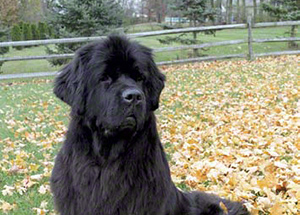Have dog, will travel – at least, that’s how it is for most of us who own dogs. There certainly are some dogs who do not like to ride in cars, but they’re relatively rare; it’s much more likely your Newfoundland puppy – and soon-to-be Newfoundland adult – will be a road-trip enthusiast. But that joy of travel comes with a serious responsibility: safety.
Most veterinarians and “serious” dog people will tell you that the “best practice” for driving with a dog is to have the dog in a securely latched crate that is itself secured in the vehicle. And they will be right; that’s the very best way to safely transport your Newfoundland (or any dog). While any appropriately sized crate will do, there are special “SUV” crates available that are a couple of inches narrower than the standard Newf sized crate width of 24”. (See now why most serious dog people drive SUVs or minivans? Those “small” crates suddenly become quite large when you squeeze them into your vehicle.) Crates ideally are secured to cargo hooks in the floor of your SUV or to the latches that hold down those seats you had to remove to fit the crates in your minivan. Keeping your dog in a secured crate ensures that neither crate nor canine becomes a projectile in case of an accident, and of course prevents your dog from interfering with the driver or any passengers. There should be an identification tag affixed to the crate with your dog’s name and a contact phone number, and that of course is in addition to the tag on your dog’s collar.
But it is also, frankly, a reality that not all dogs travel that way, and not everyone can accommodate that ideal level of car safety. There are other devices available to help keep your canine traveller safe, and you should certainly look into these. Adjustable barriers that fit right behind the front seat of your vehicle are an excellent way to ensure that your Newf stays where she belongs and doesn’t interfere with driver. Harness or restraint systems, usually used in conjunction with your car’s seat belt, are an option (admittedly, they are more likely to work with smaller breeds), and there are even restraint systems that allow dogs limited movement in a back seat or cargo area but will also keep them away from the driver. None of these systems have the safety effectiveness of crates, but they may be better than nothing.
There are also – let’s be honest here – dogs who are free in the car. (Never, never, never travel with your dog in the back of an open pickup truck; there is simply no way that can be justified. Doing so puts your dog at very high risk of serious injury and death. Just don’t do it.) The size of an adult Newfoundland is no guarantee that you won’t suddenly find yourself with a front-seat companion. The risk of distraction for a driver is much higher when dogs are free in the back of the car, and the possibility of injury increases as well. And while there’s no denying the appeal of the image of a dog with his head out the open window, feeling the breeze in his face – and most dogs certainly do seem to love that – allowing your dog to feel that breeze puts him at additional risk of eye injury. (Yes, you can buy “Doggles” to cover your dog’s eyes, but will you? And will you put in the time necessary to get him used to them?) And having the window down far enough for an adult Newf to stick their head out makes it easy for them to break the window and be injured or jump out.
The impulse to have your companion with you on excursions beyond your own yard and neighborhood is a strong one, and comes of course from the deep love we share with our dogs and with our recognition of their great delight in visiting new places and people. But honor that love by being acutely aware of the responsibility that comes every time you open the car door for your dog.

